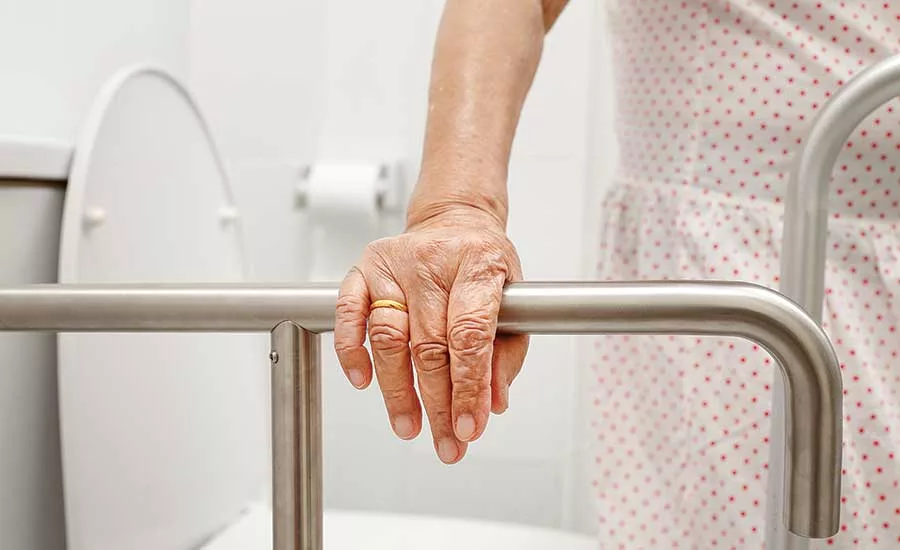New criteria for assisted toileting and bathing options gives elders extra protection in 2021 Building Codes
Building codes continue to evolve to assure the utmost comfort and accessibility for older generations.

Having fold-down grab bars on both sides of the toilet and moving the toilet away from the wall so assistance can be offered from one or both sides will make it easier, as well as safer, for both residents and caregivers.

It is critically important not to overlook the need for up-to-date requirements to ensure the safety of older adults — and the strongest need for this exists in assisted living facilities, nursing homes and rehabilitation centers.
Growing older can come with many challenges and changes. According to the U.S. Centers for Disease Control and Prevention, every year, one in four Americans over the age of 65 fall. Even worse, every 11 seconds, an older adult is treated in the emergency room for a fall, and every 19 minutes, an older adult dies from a fall.
According to National Institute on Aging, the majority of falls take place in the bathroom — 80% to be exact. The floor can get wet and slippery, and there’s an increased risk of tripping or falling getting in and out of the tub or shower.
The International Code Council’s priority is safety. While there have always been provisions for accessibility for persons with disabilities in the codes, these provisions were based on allowing independent access into and throughout a building, including independent use of the fixtures in a bathroom. As people age, they may not be strong enough for total independence. It is critically important not to overlook the need for up-to-date requirements to ensure the safety of older adults — and the strongest need for this exists in assisted living facilities, nursing homes and rehabilitation centers.
The 2021 edition of the ICC’s set of building codes include new criteria for assisted toileting and bathing. This will have a vital impact on the safety of our elders.
The ICC Committee on Healthcare (CHC) utilized new research from the Mayer-Rothschild Foundation to help develop several successful proposals for the 2021 International Building Code (IBC). The Mayer-Rothschild Foundation is a national philanthropy exclusively committed to person-centered care in long-term communities. Their study worked with residents that used a variety of mobility aids, including canes, walkers and wheelchairs; as well as asked for input from the caregivers. The resulting changes in the codes are new options for the bathrooms to be designed to allow for both access with mobility aids and assisted use of the toilet and shower in assisted living facilities, nursing homes and rehabilitation facilities.
The intent for assisted toileting and bathing is to allow for someone who has a physical disability to still feel as independent as possible, and at the same time, address the need for additional safety. For example, some elders lose their strength or have stability issues, which makes it difficult for them to stand up and down. However, having some assistance when needed will help their confidence and provide a level of independence.
Feeling safe when moving on and off the toilet is important for residents as well as caregivers. Assisting someone from the front when using the toilet has become a safety concern for both residents and caregivers over the years. Instead, having fold-down grab bars on both sides of the toilet and moving the toilet away from the wall so assistance can be offered from one or both sides will make it easier, as well as safer, for both residents and caregivers. Space for a resident using a wheelchair to maneuver for a side transfer is still provided adjacent to the toilet.
Research also looked at assisted bathing. It was found that mounted seats within the shower created a challenge for caregivers to access parts of the body of the resident they are assisting, such as their back. Whereas, a moveable seat will provide more options and easier access to assist with bathing. Grab bars on three walls provided stability for residents that preferred to stand for all or part of the shower. Space for a resident using a wheelchair is provided in front of the shower.
The bathroom as a whole will still require other accessibility features, such as a 32-inch clear-width door with maneuvering clearances, an accessible sink and a turning space within the room. These new options will be viewed as designs that are specific to the needs of the population they serve as well as provide a higher level of accessibility. The intent is to allow for design flexibility and address the safety of both residents and caregivers.
With Americans living longer and in greater numbers, building codes continue to evolve to assure the utmost comfort and accessibility for these generations. According to the CDC, 10,000 people are turning 65 years old each day. As that number grows, it is critical to have a plan in place for this group as well as the best assistance they can get.
Looking for a reprint of this article?
From high-res PDFs to custom plaques, order your copy today!






